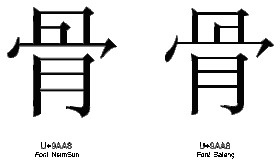Radical 188
| 骨 | ||
|---|---|---|
| 187 ⾺ ◄ | 188 | ► ⾼ 189 |
| Pinyin : | gǔ (= bone) | |
| Zhuyin : | ㄍ ㄨ ˇ | |
| Hiragana : | ほ ね hone | |
| Kanji : |
骨 偏 honehen (= radical bone) |
|
| Hangul : | 뼈 | |
| Sinocorean : | 골 | |
| Codepoint : | U + 9AA8 |
|
| Stroke sequence : |
|
|
Radical 188 , meaning “ bone ”, is one of eight traditional radicals in Chinese script , which consist of ten strokes.
With 28 character combinations in Mathews' Chinese-English Dictionary , it is relatively rare.
The character is represented slightly differently in different character sets . Compare the symbols 冎 (13 + 4) and 咼 (30 + 6).
The seal shape of this sign shows a scraped bone in the upper part, from which the original meaning scraped off resulted. In the lower part you can see the radical meat 肉. The upper part acts as a sound carrier, the lower one as a carrier of meaning.
As a bearer of meaning, 骨 establishes the connection between skeleton and bones as in:
- 髓 (in 骨髓 = bone marrow),
- 髌 (in 骨 髌 = kneecap),
- 骷髅 (= skull),
- 骸 (= body).
Character combinations ruled by radical 188
| Strokes | character |
|---|---|
| + 0 | 骨
|
| + 2 | 骩
|
| + 3 | 骪 骫 骬 骭 骮
|
| + 4 | 骯 骰 骱
|
| + 5 | 骲 骳 骴 骵 骶 骷
|
| + 6 | 骸 骹 骺 骻 骼
|
| + 7 | 骽 骾
|
| + 8 | 骿 髀 髁
|
| + 9 | 髂 髃 髄 髅
|
| +10 | 髆 髇 髈 髉 髊 髋 髌
|
| +11 | 髍 髎 髏
|
| +12 | 髐
|
| +13 | 髑 髒 髓 體
|
| +14 | 髕
|
| +15 | 髖
|
| +16 | 髗 |
In the Unicode block Kangxi radicals , radical 188 is coded under the code point number 12.219 (U + 2FBB).
literature
- Edoardo Fazzioli : Painted Words. 214 Chinese characters - from picture to concept . Marixverlag, Wiesbaden 2004, ISBN 3-937715-34-7 , p. 169 .
- For detailed references, see List of Traditional Radicals: Literature
Web links
- Xiù cai.oai.de (PDF; 1.72 MB) Explanation of Radikal 188 on page 9

